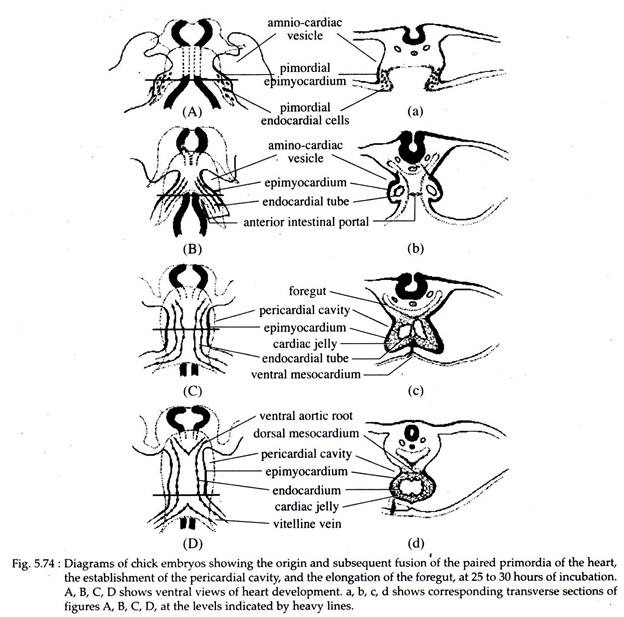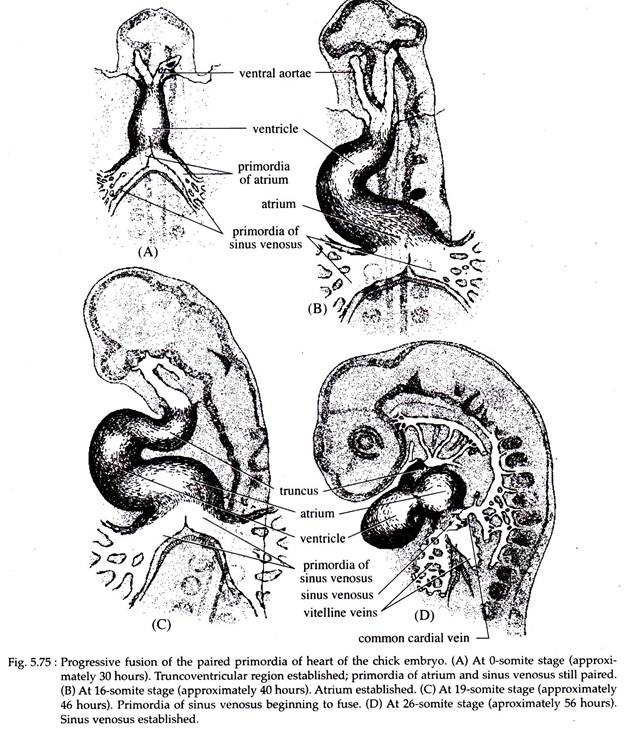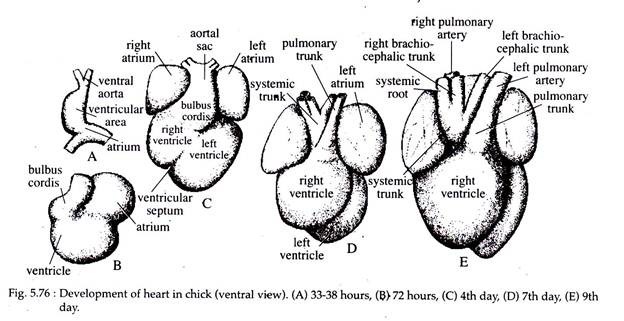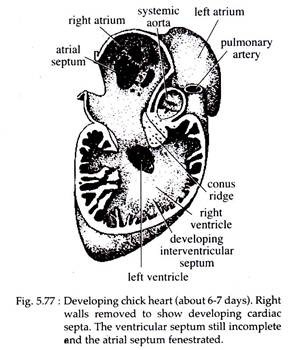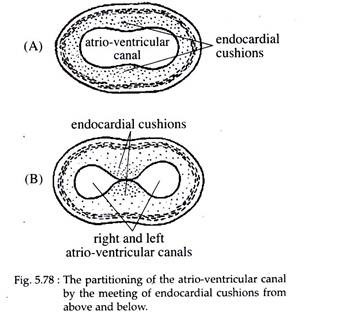In this article we will discuss about the Development of Heart in Chick :- 1. Introduction to Development of Heart in Chick 2. Origin of Heart (Formation of Endocardial Tube) in Chick 3. Beginning of Cardiac Function 4. Partitioning of the Heart 5. Valves of the Heart 6. Final Development of the Heart 7. Role of Organizer in the Development of Heart.
Contents:
- Introduction to Development of Heart in Chick
- Origin of Heart (Formation of Endocardial Tube) in Chick
- Beginning of Cardiac Function in Chick
- Partitioning of the Heart in Chick
- Valves of the Heart in Chick
- Final Development of the Heart in Chick
- Role of Organizer in the Development of Heart in Chick
1. Introduction to Development of Heart in Chick:
Two types of heart are present in the vertebrate groups – lymph hearts and the heart of the arteriovenous system. The latter one is a centralized, well-muscularized organ, present ventral to the oesophageal segment of the gut. Its function is to receive blood from the veins and to propel it forward via the arteries.
ADVERTISEMENTS:
Fundamentally the embryonic heart is composed of the following structures:
i. A thin walled sinus venosus, that connects with a series of converging veins.
ii. The atrium lying anterior to the sinus.
iii. The ventricle lying anterior to the atrium.
ADVERTISEMENTS:
iv. The bulbus cordis that contains a series of diverging arteries.
The bulbus cordis (to some extent) and the ventricle of the embryonic heart forms the main propulsive mechanism of the heart, while the atrium and sinus comprises the blood receiving areas.
2. Origin of Heart (Formation of Endocardial Tube) in Chick:
Although the adult heart is an unpaired structure, it has a bilateral origin in most vertebrates. It develops from a pair of primordia. In birds prospective heart cells can be localized in pregastrular stages.
During gastrulation, these pre-cardiac cells pass through the primitive streak and are included in the primary mesenchyme. The heart, thus, arises from the splanchnic mesoderm and it develops precociously before the body of the embryo becomes separated from the yolk sac.
ADVERTISEMENTS:
At about 24 hours of incubation in chick embryo, the coelom on each side of the anterior intestinal portion undergoes dilation to form the amniocardiac vesicles that gradually push in from each side towards the midline. The splanchnic mesoderm bounding the amniocardiac vesicles on each side undergoes thickening.
These thickenings are the primordia of the epimyocardium (Fig. 5.74). They are destined to form the external coat of the heart (epicardium) and the muscular layer of the heart (myocardium). Thereafter, cells detach from the epimyocardium and aggregate loosely between the splanchnic mesoderm and the adjacent endoderm of the intestine.
These cells form the primordium of the endocardium, (endothelial lining of the heart). Shortly, thereafter, the endocardial cells arrange themselves to produce a pair of thin-walled tubes [Fig. 5.74(b)].
While the above changes have been taking place, the closure of the foregut at the level of the heart was also progressing. As a result the paired endocardial tubes were brought progressively close together. The two endocardial tubes finally fuse into a single tube lying in the midline [Fig. 5.74(c) and (d)].
At the time of fusion of the two primordia the tubes unite sequentially starting from the union of the truncus arteriosus, followed by the ventricle, atrium and finally the sinus venosus. Thus, in a chick embryo of 30 hours of incubation, fusion of the trunco-ventricular region is complete, while the atrium and sinus venosus are still double.
The entire fusion gets completed at about the 48 hour (Figs. 5.75). If the cardia primordia are prevented from fusing by either chemical or surgical means, then separate independently beating hearts are formed on each side of the body.
While the two endocardial tubes were fusing into one, the epimyocardial layers were bending towards the midline to form a single tube around the endocardium. Ventral to the endocardial tubes the epimyocardial layers of opposite sides come into contact with each other.
ADVERTISEMENTS:
At the region of contact the limbs of the mesodermal folds next to the endocardium fuse with each other to form ventral mesocardium [Fig. 5.74(c) The ventral mesentery ruptures and disappears almost as rapidly as it is formed. Thus, the original right and left coelomic chambers become confluent to form a median unpaired pericardial cavity.
Dorsally the right and left epimyocardial layers also come close to each other. But here they do not fuse immediately as happens ventral to the heart. They persist for a time as a double-layered supporting membrane called the dorsal mesocardium [Fig. 5.74(d)], by which the primitive heart remains suspended from the floor of the pharynx.
Bending of the Tubular Primordial Heart and Establishment of its Regional Divisions:
At the end of the 2nd day and during the 3rd day of incubation, the early heart undergoes a change in shape from a straight tubular form to an S-shaped configuration (Fig. 5.76). The primitive ventricle bends to the right and the atrium travels upward above the ventricle (Fig. 5.76B).
By the end of the 3rd day the heart of chick attains the S- shaped condition. This is considered to be the first step in the development of heart in all vertebrates.
The primary factor that brings about the regional differentiation of the heart is the rapid elongation of the primitive cardiac tube, resulting in its bending into a S-shape. The factors that cause the heart to bend and also that leading to the subdivision of the heart into atrial and ventricular regions has still remained obscure.
The ventricle is formed by the bent mid- portion of the original cardiac tube. As this ventricular loop becomes progressively more extensive, it at first projects ventrally but later is brought to its characteristic adult position, caudal to the atrium. The narrow connecting portion between the ventricle and the atrium is called the atrioventricular canal.
Right from its earliest appearance, the atrium and the ventricle show external indications of their division into right and left side. A prominent median furrow (ventricular septum) appears at the apex of the ventricular loop [Fig. 5.76(c)]. The atrium meanwhile has undergone rapid dilation and bulges out as a bilobed configuration on either side of the midline.
3. Beginning of Cardiac Function in Chick:
Due to its metabolic requirements, the heart of chick embryo is required to commence beating early in its development. Thus, in chick at about 29 hours of incubation, the earliest tentative beats begin while the paired cardiac primordia are still fusing. The intensity and regularity of the heart beat increases rapidly as the cardiac primordia continues to fuse, along with the laying down of the major divisions of the heart.
The first contraction appears in the ventricle before the atrium is fully established. The initial contraction rate of the ventricle is very slow but when the atrium starts pulsating, the heart rate increases. The right heart begins to beat at a more rapid rate than the left at about the time when the sinus venosus would normally form. This is suggestive that the origin of the cardiac pacemaker is in the right cardiac primordium.
4. Partitioning of the Heart in Chick:
At the end of the 4th day, an interatrial septum between the two atrial lobes, begin to develop from the dorsoanterior area, slightly to the left of the sinus venosus opening. The interatrial septum continues to form posterior ward towards the narrow atrioventricular canal.
At the same time in the atrioventricular canal, two endocardial thickenings arise called the endocardial cushions. These are formed one dorsally and the other ventrally. At the apex of the ventricle another septum appears called the inter-ventricular septum. It grows forward towards the atrioventricular canal (Fig. 5.77).
The two endocardial cushions grow towards each other,and about the sixth day of incubation, they fuse with one another. They thus, separate the atrioventricular canal into two channels (right and left atrioventricular canals) by the formation of a cushion septum (Fig. 5.78).
The interatrial septum grows towards the endocardial cushion and finally unites with the cushion septum. The interatrial septum, however, is never completely formed during the embryonic life of chick.
A small septum or fenestrae appear in the atrial septum permitting blood to pass through it. During the last week of incubation the fenestral opening become smaller and smaller and completely closes shortly after hatching.
Meanwhile the inter-ventricular septum grows forward to unite with the cushion septum. Till the 4th day only one passage way leaves the heart via the developing bulbus cordis and ventral aorta. During the 5th day, a spiral septum begins to form within the caudal portion of the ventral aortal sac and the bulbus cordis.
Within the bulbus, this septum grows caudalward in a spiral manner, separating the pulmonary trunk ventrally and the root of the systemic aorta dorsally.
This septum continues to grow backwards also towards the inter-ventricular septum where it unites with a similar septum at the caudal end of the bulbus. At about the seventh day, the original bulbus cordis thus becomes divided into two separate vessels, a pulmonary trunk, which unites with the right ventricle and a systemic trunk, which is continuous with the left ventricle (Fig. 5.76D).
5. Valves of the Heart in Chick:
As the above progress is taking place, the valves of the heart also start forming. When the spiral septum was developing in the bulbus cordis, three semilunar or cup-shaped valves appear at the base of the systemic trunk and also at the base of the pulmonary trunk. These valves prevent the backflow of blood from the systemic trunk into the left ventricle and from the pulmonary trunk into the right ventricle.
When the cushion septum was forming, the atrioventricular or cuspid valves were formed at the two atrioventricular openings. The right auriculoventricular valve appears as a single strong muscular fold between the right chambers, while two valves make up the bicuspid valve between the left chambers. These valves prevent the back flow of blood into the atrium from the ventricles.
At the opening of the sinus into the right atrium, the right and left sides of the opening enlarge and produce folds that form the sinuatrial (sinuauricular) valves. A third valve, the Eustachian valve or sinus septum arises during the last Week of incubation, as a fold from the dorsal side of the sinus that projects into the right atrium dividing the sinuatrial opening.
6. Final Development of the Heart in Chick:
As the time approaches for hatching, the sinus venosus becomes incorporated almost completely into the wall of the right atrium, while a small portion is probably incorporated into the cardiac end of the left precaval vein (superior vena cava). The sinuatrial valves also disappear. At the time of hatching the fenestrae at the interatrial septum closes and the oxygenated and deoxygenated blood are completely separated.
7. Role of Organizer in the Development of Heart in Chick:
It has been demonstrated in case of amphibian embryos that if the endoderm is removed at the neurula stage of development, the heart fails to form. Even when fragments of pre-cardiac mesoderm are cultivated in a culture medium, normal heart tissue does not result. Thus, the endoderm exercises an essential inductive influence on the pre-cardiac myoderm.
However, in chick embryos, pre-cardiac mesodermal cells, isolated before the endoderm has formed, are capable of differentiating into cardiac muscle in vitro (Litvin et al., 1992), thus suggesting that the endodermal cells do not exercise any essential inductive influence on the formation of heart.
